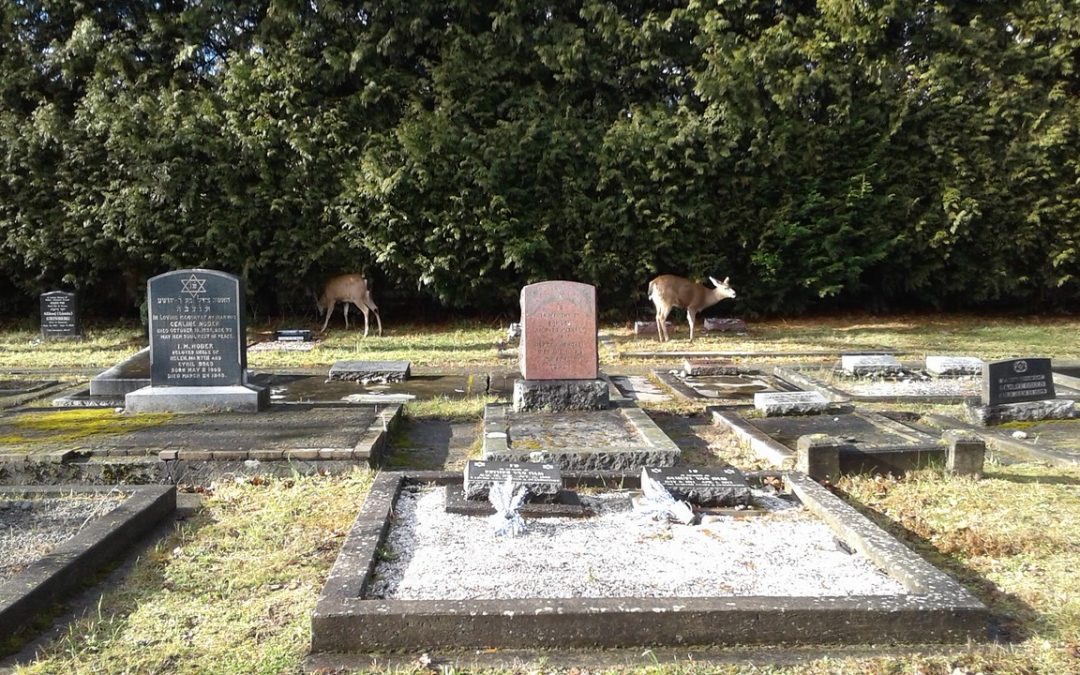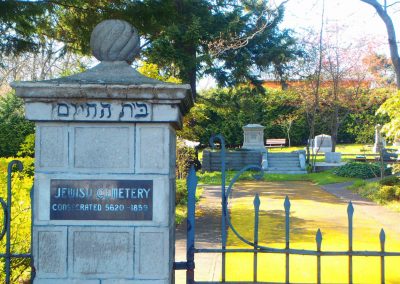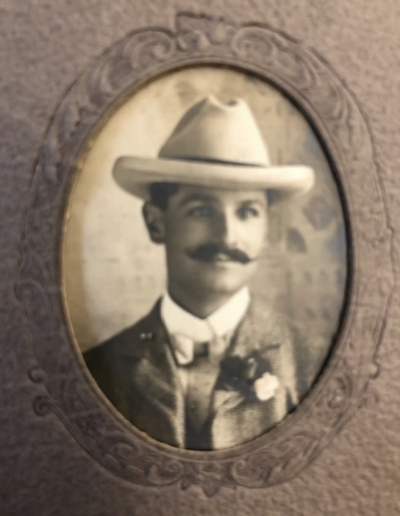Image credit: The Jewish Cemetery of Victoria, British Columbia
I thought of cemeteries as dead. The times I’ve gone have been marked by sadness, which tends to bleed out into the rest of my memories until every vision I have of these spaces is rainy. The day of my grandma’s funeral was a hot, sunny day in Calgary, but all I remember from that cemetery is gray, gray, gray. A lot of us probably feel this way. We rarely visit cemeteries beyond funerals, and the times we do are usually dominated by heavy emotions. They can feel static and dead.
We visited Victoria’s Jewish Cemetery (located on unceded lək̓ʷəŋən & W̱SÁNEĆ lands) twice this week. The space, though, is far from dead: instead, it is incredibly, noticeably living. The garry oaks wave softly in the summer breeze, birds chirp, and deer play between the granite. It’s dynamic, without a doubt (and to be honest, extremely hot). You may not think it, but the people buried here are dynamic too. The cemetery is a living, social world of its own. It’s also a space that is regularly used, visited, and cared for by the community.
While I was already beginning to feel attached to some of the people I saw here (‘Bubie to the World’ Celia Siegel comes to mind), the visit from Amber Woods, a local Jewish community historian, was a very emotional experience. To see how much care and energy went into her compilation of these stories was awe-inspiring. I come away with nothing but respect for her and for all those in the community who do this work. Through her storytelling, a rich patchwork of the cemetery’s social dynamics is revealed.
This cemetery has been through periods of decay and has been troubled by lost records, often because of a fluctuating Jewish population here. In the face of this, the Jewish community has been able to preserve and tell their histories to remarkable ends. What results is a captivating social mosaic, one that I’m feeling more and more attached to.
I’d like to tell you about one of the people I saw today. His name was Clarence B. Sylvester, nicknamed ‘Toots’, and he died in 1933. Thanks to Amber’s detailed, careful, and heartfelt descriptions, we got to learn a bit about Clarence and his family. Amber passed a photo around and I almost burst into tears at his face (I was, predictably, in the pits of an emotional fog from the day). His obituary paints him as energetic, cheerful, and driven by a love for the community. We can only see so much of the people here, particularly those who died over 100 years ago, but seeing their faces and knowing their stories can still be incredibly visceral. To me, it feels like the perfect medicine to the isolating parts of our lives.
Mind you, I have no family connection to the people here, nor am I tied to them through our city’s Jewish community. I can only imagine the emotional impact of seeing the face or story of an ancestor, family member, or friend rendered in such detail. The work of carefully gathering these stories and recording them for the community is incredibly personal, and equally important. You might only be able to see a name etched in stone, but there is also a story of a full life.
I am incredibly proud, especially after the visit from Amber and our meeting with Rabbi Harry Brechner, of the work we’re doing here. I deeply, truly want to do it as fully and compassionately as possible. In collaborating with Victoria’s Jewish community and helping to record and preserve some of these monuments, we’re able to lend our skills and tools to the community’s project of charting history.
If there’s one thing I can suggest to you, it’s this: go outside, ground yourself in your community, in physical space, find a cemetery even, and learn about our histories. I also challenge you to think of the ongoing settler-colonial context by which we are on this land. This can bring up many complicated feelings, and I push myself and you to grapple with them. We can find joy in connecting with people of the past, especially those from within our communities. We can also acknowledge, unpack, and push back against the violence that has led us here and continues today. The space of the cemetery is dynamic, complex, and living, and so are its histories. Take some time to sit with all this. Decompress from our fast-paced world, connect with things beyond yourself, and sit among the garry oaks.
The Jewish Cemetery of Victoria's Website
See the cataloguing and history of the Jewish Cemetery of Victoria, British Columbia here on their website.


